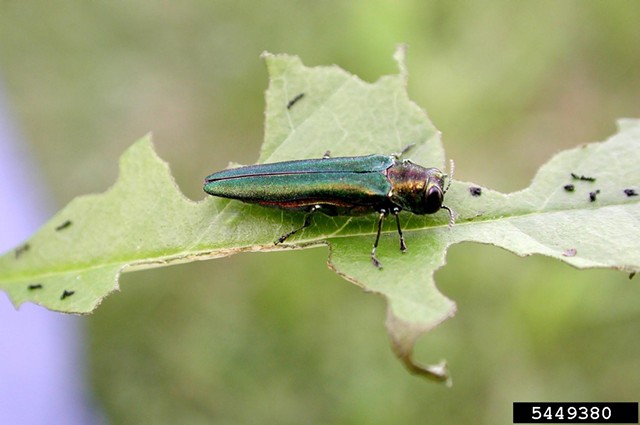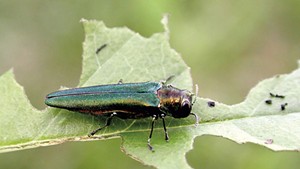
- Debbie Miller, USDA Forest Service, Bugwood.org
- An emerald ash borer
Anyone who's ever looked at a power bill knows it's filled with acronyms and obscure charges. There's "total KWH" and "storm adjustment" and numbers with five decimal places.
But one unusual line item in particular caught Chris Tan's eye as he reviewed his July bill from Green Mountain Power: a 41-cent "emerald ash borer charge."
"I check my bill every month, and there's always a list of numbers on the right. I look down those to see the final cost," Tan said. "But it wasn't until recently that I looked to the left and saw the actual name of the charge. That's when I said, 'WTF?'"
Indeed. Tan knew that his best course of action would be to contact the crack team at Seven Days to get to the bottom of this one. Just why are GMP customers paying an emerald ash borer charge?
A good place to start is with the emerald ash borer itself. Native to Asia, the invasive pest first made its mark in the U.S. near Detroit in 2002, though it likely arrived earlier. In the years since, the beetle has chewed a destructive path around the country, killing tens of millions of ash trees.
It wasn't until February 2018 that experts found the first evidence, in Orange County, that the voracious vermin had landed in the Green Mountain State. Home to some 150 million ash trees, Vermont now has confirmed infestations in large swaths of the state, including the Upper Valley and Addison, Orleans, Windham, Grand Isle and Bennington counties.
Once an infestation is confirmed, nearly all ash trees in the surrounding area are doomed to die, according to Ginger Nickerson, the forest pest education coordinator at the Vermont Urban & Community Forestry program. Proactively taking down healthy ash trees is safer — and less expensive — than waiting for the beetle to do its damage, she said. Ash trees generally are very brittle when they die, and that's even truer when the borer kills them.
"They will come apart in very unpredictable and sudden ways," Nickerson said. "And the tree just shatters."
You can see where this is going. The last thing utility companies need are exploding tree bombs next to their lines, knocking out power and potentially hurting people or property.
To combat that threat, GMP has spent the past few years creating a plan to deal with the emerald ash borer, according to spokesperson Kristin Kelly.
"The first phase involves an inventory of all ash trees along the edge of our right-of-ways in infested areas, and selectively working to remove them," she wrote in an email. "Trees that the forestry team considers at greatest risk to cause safety issues and outages due to a variety of factors are first identified for removal. Then, in the next phase, crews will move to areas that are considered high risk for infestation."
GMP supplies electricity to about 265,000 customers in Vermont. Its network serves 75 percent of the state's population and covers 75 percent of the state's geography, Kelly said. It has about 1,000 miles of transmission lines, which run between generating plants and substations, and another 11,500 miles of distribution lines, which bring power from substations to homes and businesses. The company estimates that 10 percent of the trees in its right-of-ways are ashes.
GMP proposed the emerald ash borer charge during the most recent regulatory review of the company's spending plan, which the Vermont Public Utility Commission approved in August 2019. The company intends to raise $1.2 million for ash tree removal in each of the three years the plan is in place; any surplus money would go back to customers, according to Kelly. While the exact customer charge depends on the amount of electricity used, Kelly said the typical cost is about 19 cents a month, or about $2.30 a year.
The first emerald ash borer charge appeared on October 2019 bills, Kelly said. As of June 30, 2020, the company had collected $777,000 for the work and had removed approximately 3,200 trees.
"It's an emerging concern that we're going after in a very proactive way," Kelly said. "Then once those trees are removed, they're removed. And then we're done."
This is the first time GMP has used a line-item charge to combat an invasive pest, and the technique is unique among Vermont utilities. But everyone has a plan for the beetle. Vermont Electric Coop, which serves more than 32,000 customers in the state, estimates it will cost about $3 million to remove more than 17,000 trees within striking distance of VEC lines in service areas with confirmed infestations, said Jake Brown, the nonprofit's energy services planner.
Though VEC customers aren't seeing a specific charge on their bill, they'll ultimately pay for those removals, Brown noted.
"It's a continued cost pressure on utilities that 10 years ago we might not have anticipated," he said.
About 5 to 7 percent of Vermont's trees are ashes, but the infestation won't kill all of them, Nickerson said. Some have natural resistance to the beetle, something researchers are tracking, while some municipalities and homeowners use insecticides or other treatments to try to save the trees.
Nickerson's group has scheduled an Emerald Ash Borer Awareness Week from September 12 to 19. It's urging cities and towns to come up with plans — and budgets — for dealing with the insect.
"We are finally realizing that we need to plant a wide variety of trees in urban environments, so that when the next pest comes, it does not mean we have to remove all of the trees on streets and parks," Nickerson wrote in an email.
Correction, September 2, 2020: A previous version of this article used a picture of a six-spotted tiger beetle, not an emerald ash borer. The current photo is accurate. Sorry for the error — it's bugging us too!









Comments
Comments are closed.
From 2014-2020, Seven Days allowed readers to comment on all stories posted on our website. While we've appreciated the suggestions and insights, right now Seven Days is prioritizing our core mission — producing high-quality, responsible local journalism — over moderating online debates between readers.
To criticize, correct or praise our reporting, please send us a letter to the editor or send us a tip. We’ll check it out and report the results.
Online comments may return when we have better tech tools for managing them. Thanks for reading.